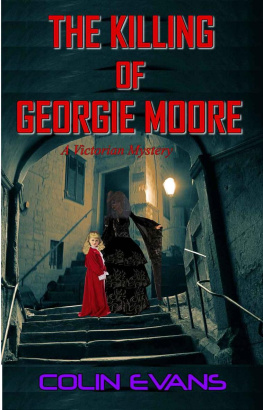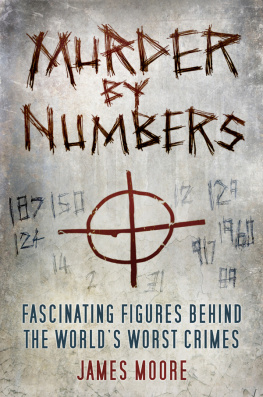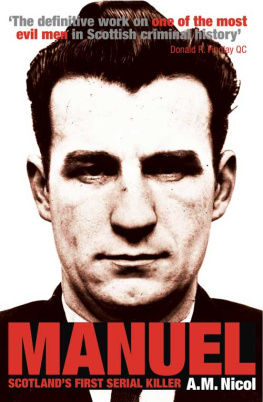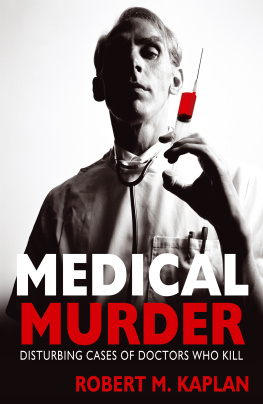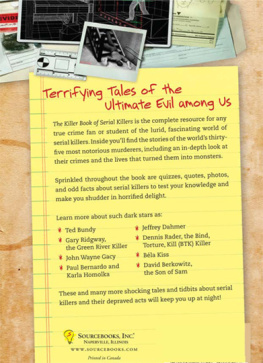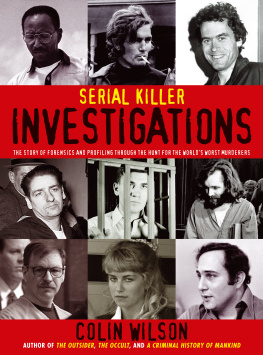KILLER DOCTORS
COLIN EVANS

BERKLEY BOOKS, NEW YORK
THE BERKLEY PUBLISHING GROUP
Published by the Penguin Group Penguin Group (USA) Inc. 375 Hudson Street, New York, New York 10014, USA Penguin Group (Canada), 90 Eglinton Avenue East, Suite 700, Toronto, Ontario M4P 2Y3, Canada (a division of Pearson Penguin Canada Inc.) Penguin Books Ltd., 80 Strand, London WC2R 0RL, England Penguin Group Ireland. 25 St. Stephens Green, Dublin 2, Ireland (a division of Penguin Books Ltd.) Penguin Group (Australia), 250 Camberwell Road, Camberwell, Victoria 3124, Australia (a division of Pearson Australia Group Pty. Ltd.) Penguin Books India Pvt. Ltd., 11 Community Centre, Panchsheel Park, New Delhi 110 017, India Penguin Group (NZ), 67 Apollo Drive, Rosedale, North Shore 0745, Auckland, New Zealand (a division of Pearson New Zealand Ltd.) Penguin Books (South Africa) (Pty.) Ltd., 24 Sturdee Avenue, Rosebank, Johannesburg 2196, South Africa
Penguin Books Ltd., Registered Offices: 80 Strand, London WC2R 0RL, England
KILLER DOCTORS
A Berkley Book / published by arrangement with the author
Copyright 1993, 2007 by Colin Evans
All rights reserved. No part of this book may be reproduced, scanned, or distributed in any printed or electronic form without permission. Please do not participate in or encourage piracy of copyrighted materials in violation of the authors rights. Purchase only authorized editions. For information, address: The Berkley Publishing Group, a division of Penguin Group (USA) Inc., 375 Hudson Street, New York, New York 10014.
ISBN: 978-1-1012-0597-6
BERKLEY
Berkley Books are published by The Berkley Publishing Group, a division of Penguin Group (USA) Inc., 375 Hudson Street, New York, New York 10014. BERKLEY is a registered trademark of Penguin Group (USA) Inc.The B design is a trademark belonging to Penguin Group (USA) Inc.
Acknowledgments
I am deeply indebted to the following people and organizations: Wayne T. Seay, chief of detectives, Nassau County Police Department; Tina Vicini, Chicago Police Department; Gerard J. Sciaraffa, Circuit Court of Cook County, Illinois; Lieutenant Dennis Bingheim and Sergeant John Summers of the Quincy, Illinois, police department; Chief Terrence M. Cunningham and Detective Peter L. McLaughlin of the Wellesley Police Department, Massachusetts; Samantha Mandor at Berkley; David Andersen; and Greg Manning. A very special thank-you to Ed Knappman and everyone at New England Publishing Associates.
Research staff at the New York Public Library, National Archives, Library of Congress, Broward County Library in Florida, the New York State Archives, the British Library, and the British Newspaper Library at Colindale, London, all provided unstinting and selfless assistance.
The usual caveat applies: while all of these people contributed so much to this book, the responsibility for any errors is mine alone.
Contents
A WOMAN SCORNED
Sex, jealousy, murder and revengethe staples of classic drama. Shakespeare fashioned a masterpiece from such stuff and called it Othello. Three and a half centuries later, in 1966, nothing much had changed except that, on this occasion, the drama was played out in two courtrooms, the press screamed Love Triangle Slaying! and the leading player was not a Moorish general but a thirty-four-year-old, darkly handsome doctor with an angular smile. He did have a stagey ring to his name, thoughCarl Anthony Coppolino.
He grew up the son of a barber in Brooklyn, New York. The Coppolinos were typical of the neighborhood they lived innever quite enough money at the end of the week for extras, but no great shortages either. Just an average, everyday family. Except that Carl was far from being the average kid. In the first place he was bright, very bright; secondly, his ambition was ruthless and knew no bounds. He worked hard at school, saved up his allowance and secured a place at Fordham University where he studied medicine. On campus he kept himself to himself, even though his lean features drew plenty of admiring glances from the coeds. He seemed preoccupied with his work and, anyway, he was already dating seriously.
Carmela Musetto first met Coppolino in 1952 when she was a pre-med student at Trinity College in Washington DC. She was as cute as a button and the two hit it off right away, despite big differences in their backgrounds. Whereas Coppolino constantly had to struggle to meet costly tuition fees, Carmelas father, a successful physician, was always on call whenever his daughter needed a helping financial hand. In 1956 Carmela joined Coppolino at the Downstate Medical Center. That same year she also became his bride.
The arrival of a baby daughter, Monica, sent Coppolinos perpetual money problems into a serious tailspin. Only a bailout from Carmelas father enabled him to finish his studies and qualify as an MD. After graduation both he and his wife did their internships at the Methodist Hospital in Brooklyn. From there, Carmela decided against regular practice and took a position as a research physician with a large pharmaceutical firm, while Coppolino became staff anesthesiologist at Riverview Hospital in Red Bank, New Jersey.
It was around this time that Coppolino first became interested in hypnosis. In the fifties hypnosis was just beginning to gain credibility as a useful medical tool. Coppolino was quick to realize its possibilities and soon became a skilled practitioner. He would induce patients to relax before surgery and also assist them in dealing with postoperative discomfort. Aside from the obvious medical benefits, Coppolino also saw hypnosis as a handy means of substantially boosting his income. He began treating patients at home, helping to rid them of undesirable habits or to alleviate pain. He prospered, but still the extra money wasnt enough; he kept pushing for more. At Riverview his reputation was that of a whiner, forever carping about the paltry salary paid to anesthesiologists. As his greed worsened, so did his temper. Inexorably, the darker side of Carl Coppolinos nature began to surface.
He became obsessive about one of the staff nurses, constantly bitching to his colleagues that she was receiving money which rightfully should have gone to them. It was an extraordinary accusation to make, entirely without foundation, but Coppolino was unrelenting. Soon the nurse was on the receiving end of a barrage of abusive letters and anonymous phone calls, all telling her to quit the hospitalor else. At first she shrugged off the threats but, as their intensity grew so did her apprehension and she contacted the authorities. An FBI agent visited the hospital. He speedily concluded that the virulent campaign had its origins inside the hospital. His suspicions were aroused by a room which housed several typewriters. Forensic tests proved that at least some of the threatening letters had been written on these very machines. Next, he checked out who used the room most often. The name of Dr. Carl Coppolino kept cropping up. Coppolinos animosity toward the nurse was remembered and led to a confrontation. He made no great pretense of denying anything, and the hospital, anxious to avoid scandal, allowed him to resign quietly without pressing any charges.
Coppolino explained away the resignation to acquaintances as medically caused, the result of a persistent heart condition. As if to prove the point he filed a claim with his insurance company for disability benefits. It was later learned that he had dosed himself with digitalis which produces abnormal patterns in electrocardiograms, irregularities easily mistaken for heart disease. Grudgingly, the insurance company began paying him $1,500 a month. Added to this, his wifes annual salary of $15,000 was enough for Dr. Carl Coppolino to retire on. Best of all, he was still only thirty years old.


